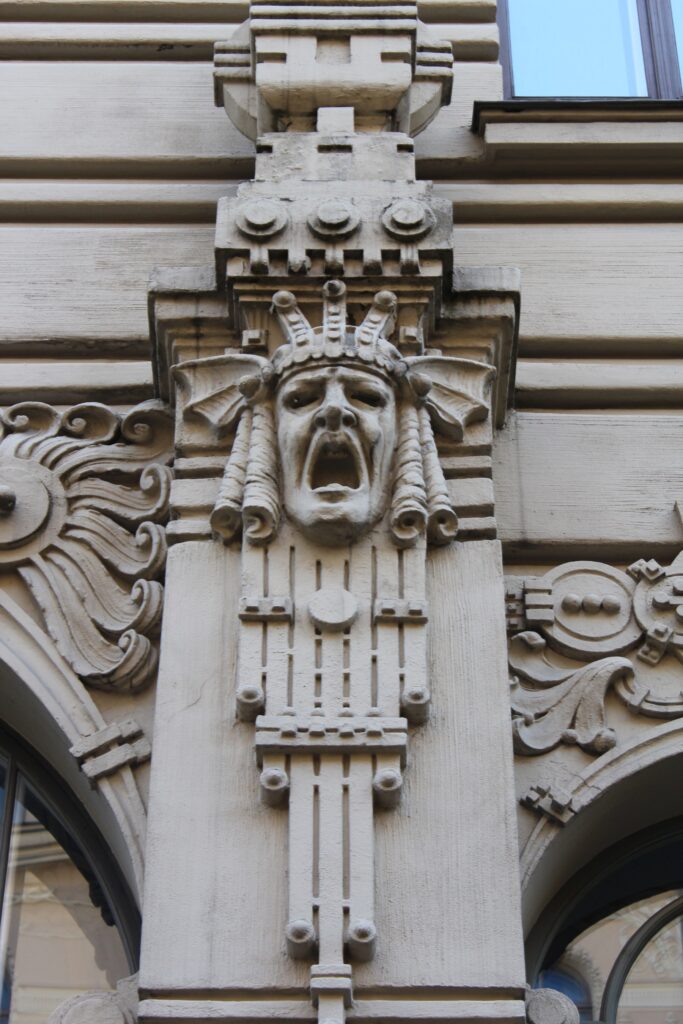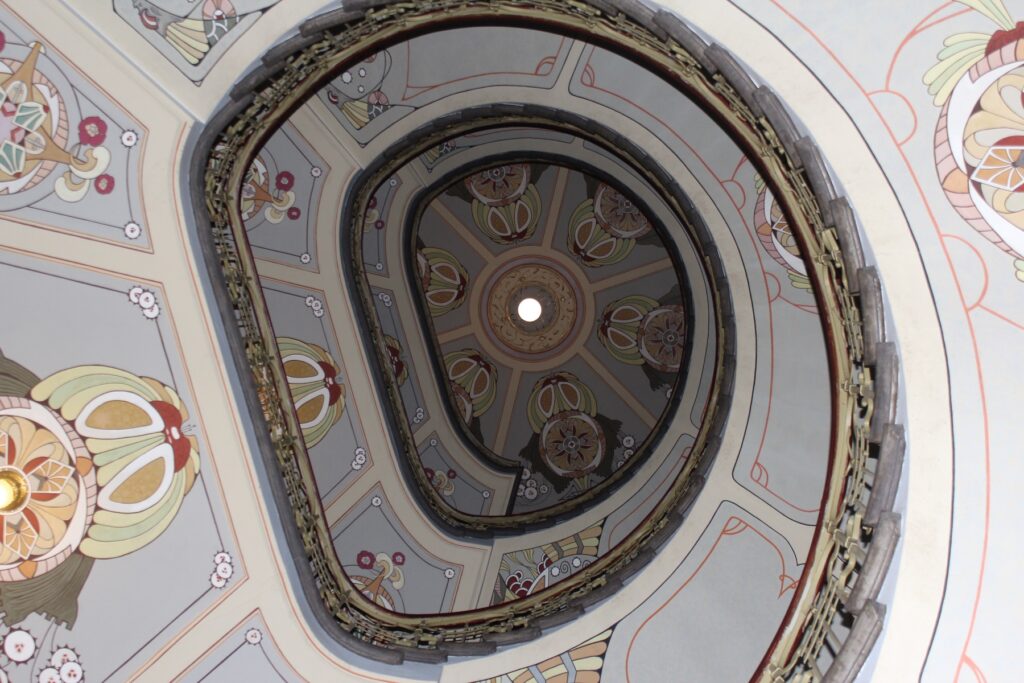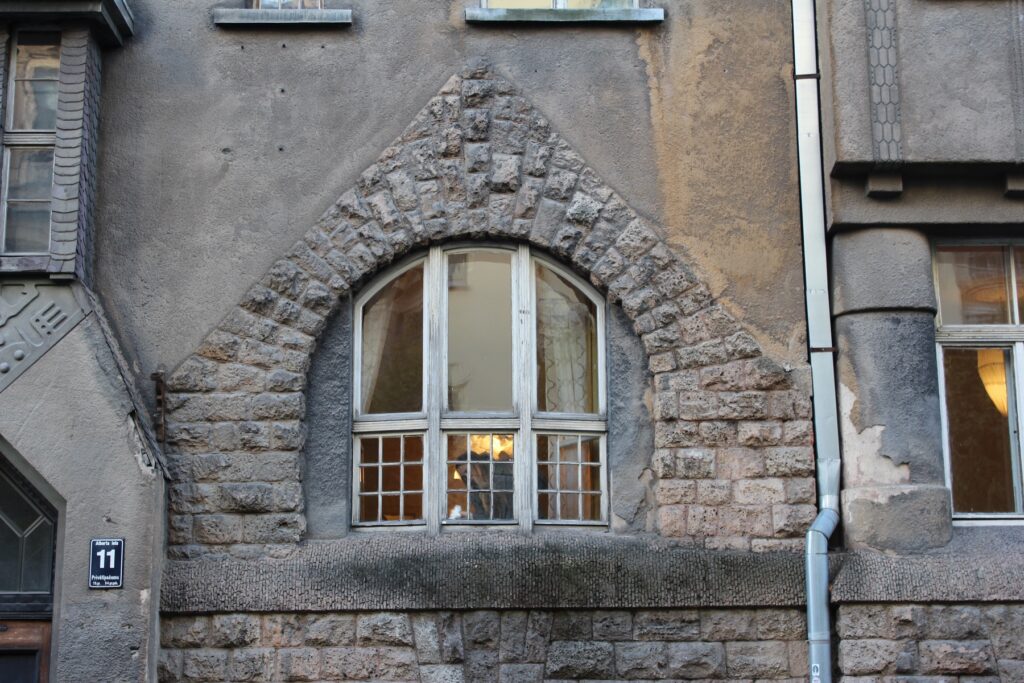In 1997, the historic centre of the Latvian capital of Riga was inscribed on the UNESCO World Heritage List. The historic centre of Tallinn, the capital of Estonia, Latvia’s northern neighbour, made the list at the same time. Both cities were praised for their medieval cores, a legacy of their history as important ports of the Hanseatic League, the Germanic confederation of merchant towns that dominated Baltic trade from the 13th to the 15th centuries.
But while Tallinn’s inscription covered just the 113ha of its medieval town, for Riga it covered 438ha, stretching well beyond the medieval core to encompass the districts beyond, built up with residential blocks in the early 1900s. The reason? These districts offer what is described by UNESCO as ‘the finest collection of Art Nouveau buildings in Europe.’
Art Nouveau emerged across Europe in the 1890s as a reaction against the prevailing currents of historicism and eclecticism. The functionality of objects and buildings was central to Art Nouveau, but they were turned into works of art through the use of sinuosity of line, motifs taking inspiration from sources ranging from nature to the Orient, and by the innovative use of materials such as iron and glass.
The movement took different names in different parts of the continent. In Italy, for example, it was known as Liberty style, a name that has nothing to do with the awakening of political consciousness but was instead drawn from the London department store known for bringing in textiles and other objects from the Far East. In Germany, it took the name Jugendstil, deriving from an art magazine founded in Munich that promoted the movement. In Latvia, the movement is known as Jūgendstils.

But why is there such a concentration of Art Nouveau buildings in Riga? The answer lies in the rapid growth of the city, an important port and industrial centre of imperial Russia, at the turn of the 20th century – exactly during the period when Art Nouveau was in vogue. For a long period until the mid-19th century, only timber buildings were permitted to be built outside of the fortified centre, a stipulation with its root in Russian defence planning. But times, and the military picture, changed, and in 1856 the tsar agreed to the demolition of the fortifications. A new city layout emerged, with an elegant arc of parks and boulevards surrounding the medieval core.
Beyond these, apartment buildings several storeys in height were erected and, with economic boom years around the turn of the century accompanied by marked rural to urban migration and the rapid growth of the city’s population, an acceleration of this process coincided with the peak in fashion of the Art Nouveau style. An exhibition in 1901 marking the celebrations of the 700th anniversary of Riga helped promote Art Nouveau designs to an international audience, in the same way the Paris Exposition had done a year earlier.
Alberta iela: Riga’s Art Nouveau showcase
A modestly sized street in a part of the city known appropriately as the Quiet Centre, Alberta iela is the target for visitors in search of the best of Riga’s Art Nouveau. The central draw here is a line of apartment blocks along the northern side of the street built at the beginning of the 20th century by architect Mikhail Eisenstein, whose son Sergei was the celebrated film director known for the silent masterpiece Battleship Potemkin. The buildings are exuberant, festooned with decoration including human figures, both real and mythological, and floral motifs and masks, giving the whole side of the street the feel of an elaborate stage set.
The five-storey building at 2A has a façade that extends a further floor just to provide a canvas for yet more ornamentation, with rather satisfied-looking female faces gazing down from the heights of the building. The female faces below are screaming in anger, clearly distressed at their less-exalted position. Clusters of seven vertical stripes, with the central stripe the longest, hang down from these, a common feature of the ornamentation of early Art Nouveau buildings in Riga. Bare-breasted female figures holding torches stand on top of the anguished heads, which can’t be doing their mood any good. A pair of sphinxes sporting remarkably long noses flank the entrance to the building, which was the early childhood home of philosopher Sir Isaiah Berlin.
The female face above the door of number 4 is particularly serene, surprisingly so given the large wings extending from either side of her head. Reliefs of winged lions guard the entrance, and there are more statues of lions on top of the building, staring out in opposite directions. The framing of the windows of the fifth floor forms a keyhole shape – another common feature of Riga’s Art Nouveau buildings.
The façade at Alberta iela 8 centres on a protruding semi-cylindrical structure, offering two floors of bay windows. Vertical lines of light blue brickwork colour a façade rich in ornament, with reliefs filling the spaces between lines of windows. There are more serene female faces, contrasting sharply with the screaming Medusa, hair a mass of writhing snakes, over a gate at number 7 opposite.
Another Eisenstein concoction is at Alberta iela 13, on the corner with Strēlnieku iela, again a riot of ornamentation, with a particularly varied range of depictions of female figures: as statues, reliefs and faces; smiling, serene and shocked. There is also a row of rams’ skulls above the first-floor windows, plus peacocks and a relief of Pan playing the pipes. The building now houses the Riga Graduate School of Law, along with the Irish Embassy and the offices of several non-governmental organisations.
Next door, at Strēlnieku iela 4A, is another Eisenstein apartment block, today housing the Stockholm School of Economics. What look rather like imagined space helmets sit above the ground-floor windows. The façade features scantily dressed female figures holding up wreaths, and bare-breasted ladies looking out from the prows of ships, which have dropped anchor to create the vertical lines so beloved in Riga’s Art Nouveau decoration. Colour is added by patches of light blue brickwork.

On another corner of Alberta and Strēlnieku streets is the yellow-painted block at Alberta iela 12, with a sharply pointed corner tower, a decoration of pine cones and pine needles covering balconies and surrounding the entrance, and Renaissance-inspired loggias. It was the work of the prolific and versatile Latvian architect Konstantīns Pēkšēns, who liked the building so much, he made it his home.
The ground floor and basement now conveniently accommodate the Riga Art Nouveau Centre, a museum dedicated to the style, with staff sporting period costumes. A hologram of Konstantīns Pēkšēns himself, or at least an actor dressed in the manner of the architect, welcomes you into his home. The centre neatly complements a walking tour of Riga’s Art Nouveau buildings by offering a well-researched reconstruction of an apartment kitted out in all things Art Nouveau.
There is a plant-festooned bay window in the living room, whose walls are decorated by an ornamental band studded with daisy motifs. The room is watched over by a photograph of Pēkšēns, as if to ensure that visitors don’t become over familiar with the place. The dining room offers floral stained-glass windows, as well as paintings on the ceiling. A poky maid’s room off the kitchen reminds of the social stratification in the Riga of the turn of the 20th century. The apartment was kitted out with the latest in the technologies of personal hygiene, including an enamel bath and, in the smallest room of the flat, a state-of-the-art latrine immodestly titled ‘The Incomparable Closet’, imported from England.
There is a second museum on the fifth floor of the building: the apartment home of Latvian painter Janis Rozentāls, whose versatile output embraced the Art Nouveau style. There is no lift, but the climb is made more pleasurable by the delightful spiral staircase, itself an Art Nouveau masterpiece. The museum houses several paintings by Rozentāls, both in his apartment itself and his airy studio in the attic above, reached up some wooden stairs.
The apartment honours two Latvian cultural greats in one, as the then ailing writer Rūdolfs Blaumanis lived in the apartment as a tenant for a couple of years, and has a room dedicated to his works. It is an atmospheric place, though there is little information on offer, with a sign at the entrance warning darkly that those who would like to learn more should book a guided tour.
An Art Nouveau tour around Alberta iela is neatly rounded off by a stop at Art Nouveau Rīga, the souvenir shop located directly over the road from the entrance to the apartment block housing
the museums. It offers a wide selection of Art Nouveau-themed items, from mugs, notebooks and greeting cards to more expensive ornaments.
The old town
Riga’s old town, many of whose buildings have been remodelled and replaced over the centuries, also offers some delightful Art Nouveau works. Another of Pēkšēns’s creations lies at 2 Smilšu iela, its façade decorated by bricks of different shades of brown. Dating from 1902, it is among the earlier Art Nouveau buildings in Riga.
A protruding part of the façade is held up by three columns; the central one takes the form of a spreading tree, while those to either side are female and male figures, emerging organically from tree trunks. Local guides will tell you that the bare-breasted female figure on the left was the winner of a beauty contest among the Art Nouveau statuary of the city: a remarkable result for a lady sporting wood in lieu of legs. A peacock above displays its tail feathers, as if to make a statement on the beauty of the building.
Among the most photogenic of the Art Nouveau buildings in the old town is the polychrome confection at Kalēju iela 23, the work of Jewish architect Paul Mandelstamm, who was later a victim of the Holocaust. Its entrance doorway is decorated with a hood featuring painted trees and a line of daisies. A lamp in the form of a drooping plant curls forward over the entrance. Around the window above, the rays of a golden sun, together with the window itself, form the keyhole shape so beloved of Riga’s Art Nouveau architects.
Emphasising the vertical
The showy, ornament-laden creations of Eisenstein and the similar buildings dotted in other parts of the city by no means, however, tell the whole story of Riga’s Art Nouveau architecture. Indeed, according to Jānis Krastiņš, professor at Riga Technical University and an authority on the Art Nouveau architecture of the city, some of these feature the Art Nouveau ornamentation of buildings whose composition otherwise harks back to earlier architectural styles.
From around 1907, these eclectically decorated buildings made way for a new style of Art Nouveau, Perpendicular Art Nouveau, which features a strongly emphasised verticality, frequently achieved through vertical bands and building projections accommodating bay windows. Ornamentation is rather less pronounced, though will still frequently be present, for example in filling the spaces between rows of windows. Many of Riga’s Art Nouveau buildings do not though fall neatly into one style, but incorporate elements of two or more styles.
The architect Jānis Alksnis was among the champions of Perpendicular Art Nouveau, and the apartment building at Lāčplēša iela 18 is an early example. Verticality is emphasised by projections running up and down for three storeys on either side of the façade, as well as by the decoration around the windows. Beneath the gables recline a male and female figure – the man bearded and clothed, the lady younger looking and bare breasted – who stare disdainfully away from each other. A childlike figure with a startled expression sits between them. One wonders what has just been said or done.
In the old town, the former building of the Mutual Aid Society for Farmers of the Governorate of Livonia, at Vaļņu iela 2, is another example of Perpendicular Art Nouveau, where projections on the façade again emphasise verticality. Athletic male and female figures adorn reliefs either side of the main entrance to the building, which now houses the Latvian Ministry of Education and Science.
National Romanticism
A Latvian national movement had emerged in the 19th century, in a country that had long been dominated by a Baltic German elite and was part of the Russian Empire and, by the turn of the 20th
century, Riga itself was becoming rapidly more Latvian in feel, through the rural to urban migration of predominantly ethnic Latvians. A third current of Riga’s Art Nouveau architecture was influenced by, and in turn supported, this developing Latvian national consciousness, known as National Romanticism.
Architects sought to draw on the traditions and spirit of the Latvian people in crafting an architectural style that emphasised the use of natural building materials like stone, drew on ethnographic patterns, characteristically featured steep roofs, and whose buildings were often rather bulky in feel. There was some cross-fertilisation with similarly inspired styles emerging in other countries on the peripheries of the empire, notably Finland.

A young architect named Eižens Laube was among those to champion the style, and one of Laube’s most notable works forms the odd building out at Alberta iela 11. Sitting among Eisenstein’s eclectically decorated concoctions, the apartment house features heavy blocks of stone at the base of the façade, surmounted by plasterwork of various shades of grey and brown, rising to a strongly pointed roof. There are ethnographic motifs above the doorways, spaces between windows are enlivened with sun designs crafted from copper strips placed on a slate backing, and semi-cylindrical projections accommodate bay windows.
The apartment block at Valdemāra iela 18, the work of Augusts Malvess, has a façade enlivened by contrasting red and cream plasterwork and by blocks of stone. A frieze running between the
second and third floors recalls the patterning of a traditional Latvian belt, and more ethnographic designs flank the projecting sections housing bay windows. These rise up to the roof, terminating in gables framed by horseshoe-shaped cornices. The building is now home to a place called Ze Donats, aka The Donuts, where a walk in search of Riga’s Art Nouveau architecture can usefully be sustained with one of their eccentrically named donut varieties. The berry version is called a Forests Gamps, for some reason.
Art Nouveau had petered out in Riga even before the travails of World War I and the Latvian War of Independence that followed. Other architectural currents had moved in, though in some cases in a hybrid form that for a while retained elements of Art Nouveau, such as a Neo-Classical Art Nouveau that characterises the rebuilt Riga Latvian Society House at Merķeļa iela 13, a building whose façade is enlivened by murals painted by Janis Rozentāls.
The legacy of those few years of the intensive construction of Art Nouveau buildings at the turn of the 20th century is, however, a remarkable cityscape in a place that knows how to put on the Jugendstil.
More information
Paul Brummell is a career diplomat, currently serving as the ambassador of the United Kingdom to Latvia. He is the author of Bradt’s guides to Turkmenistan and Kazakhstan, and co-author of the Bradt Guide to Romania: Transylvania.
This piece was originally published in The Travel Club, a monthly members-only e-zine from Bradt Guides. To sign up from just £5 a month, which includes access to the magazine and 50% off all Bradt guides, click here.